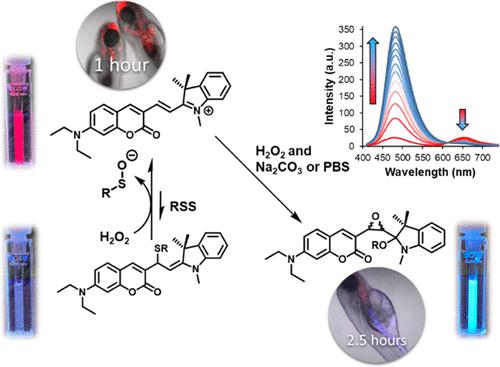当前位置:
X-MOL 学术
›
Anal. Chem.
›
论文详情
Our official English website, www.x-mol.net, welcomes your
feedback! (Note: you will need to create a separate account there.)
Unraveling the Chemosensing Mechanism by the 7-(Diethylamino)coumarin-hemicyanine Hybrid: A Ratiometric Fluorescent Probe for Hydrogen Peroxide
Analytical Chemistry ( IF 6.7 ) Pub Date : 2022-07-27 , DOI: 10.1021/acs.analchem.2c01852 Ryan E Johnson 1 , Joshua M van der Zalm 1 , Aicheng Chen 1 , Ian J Bell 2 , Terence J Van Raay 2 , M Sameer Al-Abdul-Wahid 3 , Richard A Manderville 1
Analytical Chemistry ( IF 6.7 ) Pub Date : 2022-07-27 , DOI: 10.1021/acs.analchem.2c01852 Ryan E Johnson 1 , Joshua M van der Zalm 1 , Aicheng Chen 1 , Ian J Bell 2 , Terence J Van Raay 2 , M Sameer Al-Abdul-Wahid 3 , Richard A Manderville 1
Affiliation

|
The hemicyanine hybrid containing the 7-(diethylamino)coumarin (ACou) donor attached to the cationic indolenium (Ind) acceptor through a vinyl linkage (ACou-Ind) represents a classic ratiometric fluorescent probe for detecting nucleophilic analytes, such as cyanide and reactive sulfur species (RSS), through addition reactions that disrupt dye conjugation to turn off red internal charge transfer (ICT) fluorescence and turn on blue coumarin emission. The chemosensing mechanism for RSS detection by ACou-Ind suggested in the literature has now been revised. Our studies demonstrate that thiolates react with ACou-Ind through conjugate addition to afford C4-SR adducts that lack coumarin fluorescence due to photoinduced electron transfer quenching by the electron-rich enamine intermediate. Thus, ACou-Ind serves as a turn-off probe through loss of red ICT fluorescence upon RSS addition. The literature also suggests that blue coumarin emission of thiolate adducts is enhanced in the presence of reactive oxygen species (ROS) due to ROS-mediated cellular changes. Our studies predict that such a scenario is unlikely and that thiolate adducts undergo oxidative deconjugation in the presence of H2O2, the pervasive ROS. Under basic conditions, H2O2 also reacts directly with ACou-Ind to generate intense coumarin fluorescence through an epoxidation process. The relevance of our chemosensing mechanism for ACou-Ind was assessed within live zebrafish, and implications for the utility of ACou-Ind for unraveling the interplay between RSS and ROS are discussed.
中文翻译:

7-(二乙氨基)香豆素-半花青杂化物的化学传感机制:过氧化氢的比例荧光探针
含有 7-(二乙氨基)香豆素 (ACou) 供体的半花青杂化物通过乙烯基键 (ACou-Ind) 连接到阳离子茚 (Ind) 受体上,代表了用于检测亲核分析物(例如氰化物和活性硫)的经典比率荧光探针物种(RSS),通过破坏染料结合的加成反应关闭红色内部电荷转移(ICT)荧光并打开蓝色香豆素发射。文献中建议的 ACou-Ind 检测 RSS 的化学传感机制现已修订。我们的研究表明,硫醇盐通过共轭加成与 ACou-Ind 反应,提供由于富电子烯胺中间体的光诱导电子转移猝灭而缺乏香豆素荧光的 C4-SR 加合物。因此,ACou-Ind 在添加 RSS 时通过红色 ICT 荧光的损失用作关闭探针。文献还表明,由于 ROS 介导的细胞变化,在存在活性氧 (ROS) 的情况下,硫醇盐加合物的蓝色香豆素发射增强。我们的研究预测,这种情况不太可能发生,硫醇盐加合物在 H 存在下会发生氧化解共轭。2 O 2,普遍存在的活性氧。在碱性条件下,H 2 O 2也直接与ACou-Ind反应,通过环氧化过程产生强烈的香豆素荧光。我们在活斑马鱼中评估了我们对 ACou-Ind 化学传感机制的相关性,并讨论了 ACou-Ind 对揭示 RSS 和 ROS 之间相互作用的效用的意义。
更新日期:2022-07-27
中文翻译:

7-(二乙氨基)香豆素-半花青杂化物的化学传感机制:过氧化氢的比例荧光探针
含有 7-(二乙氨基)香豆素 (ACou) 供体的半花青杂化物通过乙烯基键 (ACou-Ind) 连接到阳离子茚 (Ind) 受体上,代表了用于检测亲核分析物(例如氰化物和活性硫)的经典比率荧光探针物种(RSS),通过破坏染料结合的加成反应关闭红色内部电荷转移(ICT)荧光并打开蓝色香豆素发射。文献中建议的 ACou-Ind 检测 RSS 的化学传感机制现已修订。我们的研究表明,硫醇盐通过共轭加成与 ACou-Ind 反应,提供由于富电子烯胺中间体的光诱导电子转移猝灭而缺乏香豆素荧光的 C4-SR 加合物。因此,ACou-Ind 在添加 RSS 时通过红色 ICT 荧光的损失用作关闭探针。文献还表明,由于 ROS 介导的细胞变化,在存在活性氧 (ROS) 的情况下,硫醇盐加合物的蓝色香豆素发射增强。我们的研究预测,这种情况不太可能发生,硫醇盐加合物在 H 存在下会发生氧化解共轭。2 O 2,普遍存在的活性氧。在碱性条件下,H 2 O 2也直接与ACou-Ind反应,通过环氧化过程产生强烈的香豆素荧光。我们在活斑马鱼中评估了我们对 ACou-Ind 化学传感机制的相关性,并讨论了 ACou-Ind 对揭示 RSS 和 ROS 之间相互作用的效用的意义。









































 京公网安备 11010802027423号
京公网安备 11010802027423号